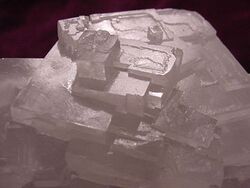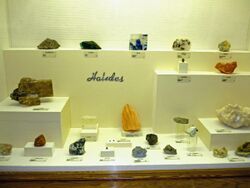Chemistry:Halide minerals
It include those minerals with a dominant halide anion (F−, Cl−, Br− and I−). Complex halide minerals may also have polyatomic anions.[1]
Examples include the following:[2][3]
- Atacamite Cu2Cl(OH)3
- Avogadrite (K,Cs)BF
- Bararite (ß)(NH4)2SiF6
- Bischofite (MgCl2·6H2O)
- Brüggenite Ca(IO3)2(H2O)
- Calomel HgCl
- Carnallite KMgCl3·6H2O
- Carnallite KMgCl·6H2O
- Cerargyrite/Horn silver AgCl
- Chlorargyrite AgCl, bromargyrite AgBr, and iodargyrite AgI
- Cryolite Na3AlF6
- Cryptohalite (a)(NH4)2SiF6
- Dietzeite Ca2(IO3)2CrO4
- Eglestonite Hg4OCl2
- Embolite AgCl+AgBr
- Eriochalcite CuCl2·2H2O
- Fluorite CaF2
- Halite NaCl
- Lautarite Ca(IO3)2
- Marshite CuI
- Miersite AgI
- Nantokite CuCl
- Sal Ammoniac NH4Cl
- Sylvite KCl
- Terlinguaite Hg2OCl
- Tolbachite CuCl2
- Villiaumite NaF
- Yttrocerite (Ca,Y,Ce)F2
- Yttrofluorite (Ca,Y)F2
[4] Many of these minerals are water-soluble and are often found in arid areas in crusts and other deposits as are various borates, nitrates, iodates, bromates and the like. Some, such as the fluorite group, are not water-soluble. All or most of simple halides of fluorine through iodine of all of the natural alkali metals and alkaline earth metals as well as numerous other metals and cations are found in some quantity at one or more locations. More complex minerals as shown below are also found. [5]
Commercially significant halide minerals
Two commercially important halide minerals are halite and fluorite. The former is a major source of sodium chloride, in parallel with sodium chloride extracted from sea water or brine wells. Fluorite is a major source of hydrogen fluoride, complementing the supply obtained as a byproduct of the production of fertilizer. Carnallite and bischofite are important sources of magnesium. Natural cryolite was historically required for the production of aluminium, however, currently most cryolite used is produced synthetically.
Many of the halide minerals occur in marine evaporite deposits. The Atacama Desert also has large quantities of halide minerals as well as chlorates, iodates, oxyhalides and the like as well as nitrates, borates and other water-soluble minerals—not only underground but it crusts on the surface due to the low rainfall—the Atacama is the world's driest desert as well as one of the oldest (25 million years)
Nickel–Strunz Classification -03- Halides
IMA-CNMNC proposes a new hierarchical scheme (Mills et al., 2009). This list uses the Classification of Nickel–Strunz (mindat.org, 10 ed, pending publication).
- Abbreviations:
- "*" – discredited (IMA/CNMNC status).
- "?" – questionable/doubtful (IMA/CNMNC status).
- "REE" – Rare-earth element (Sc, Y, La, Ce, Pr, Nd, Pm, Sm, Eu, Gd, Tb, Dy, Ho, Er, Tm, Yb, Lu)
- "PGE" – Platinum-group element (Ru, Rh, Pd, Os, Ir, Pt)
- 03.C Aluminofluorides, 06 Borates, 08 Vanadates (04.H V[5,6] Vanadates), 09 Silicates:
- Nickel–Strunz code scheme: NN.XY.##x
- NN: Nickel–Strunz mineral class number
- X: Nickel–Strunz mineral division letter
- Y: Nickel–Strunz mineral family letter
- ##x: Nickel–Strunz mineral/group number, x add-on letter
Class: halides
- 03.A Simple halides, without H2O
- 03.AA M:X = 1:1, 2:3, 3:5, etc.: Panichiite; 05 Nantokite, 05 Marshite, 05 Miersite; 10 Iodargyrite, 10 Tocornalite; 15 Bromargyrite, 15 Embolite*, 15 Chlorargyrite; 20 Carobbiite, 20 Griceite, 20 Halite, 20 Sylvite, 20 Villiaumite; 25 Sal ammoniac, 25 Lafossaite; 30 Calomel, 30 Kuzminite, 30 Moschelite; 35 Neighborite; 40 Chlorocalcite, 45 Kolarite, 50 Radhakrishnaite; 55 Hephaistosite, 55 Challacolloite
- 03.AB M:X = 1:2: 05 Tolbachite, 10 Coccinite, 15 Sellaite; 20 Chloromagnesite*, 20 Lawrencite, 20 Scacchite; 25 Frankdicksonite, 25 Fluorite; 30 Tveitite-(Y); 35 Gagarinite-(Y); 35 Zajacite-(Ce)
- 03.AC M:X = 1:3: 05 Zharchikhite, 10 Molysite; 15 Fluocerite-(Ce), 15 Fluocerite-(La), 20 Gananite
- 03.B Simple Halides, with H2O
- 03.BA M:X = 1:1 and 2:3: 05 Hydrohalite, 10 Carnallite
- 03.BB M:X = 1:2: 05 Eriochalcite, 10 Rokuhnite, 15 Bischofite, 20 Nickelbischofite, 25 Sinjarite, 30 Antarcticite, 35 Tachyhydrite
- 03.BC M:X = 1:3: 05 Chloraluminite
- 03.BD Simple Halides with H2O and additional OH: 05 Cadwaladerite, 10 Lesukite, 15 Korshunovskite, 20 Nepskoeite, 25 Koenenite
- 03.C Complex Halides
- 03.C: Steropesite, IMA2008-032, IMA2008-039
- 03.CA Borofluorides: 05 Ferruccite; 10 Avogadrite, 10 Barberiite
- 03.CB Neso-aluminofluorides: 05 Cryolithionite; 15 Cryolite, 15 Elpasolite, 15 Simmonsite; 20 Colquiriite, 25 Weberite, 30 Karasugite, 35 Usovite; 40 Pachnolite, 40 Thomsenolite; 45 Carlhintzeite, 50 Yaroslavite
- 03.CC Soro-aluminofluorides: 05 Gearksutite; 10 Acuminite, 10 Tikhonenkovite; 15 Artroeite; 20 Calcjarlite, 20 Jarlite, 20 Jorgensenite
- 03.CD Ino-aluminofluorides: 05 Rosenbergite, 10 Prosopite
- 03.CE Phyllo-aluminofluorides: 05 Chiolite
- 03.CF Tekto-aluminofluorides: 05 Ralstonite, 10 Boldyrevite?, 15 Bogvadite
- 03.CG Aluminofluorides with CO3, SO4, PO4: 05 Stenonite; 10 Chukhrovite-(Nd), 10 Chukhrovite-(Ce), 10 Chukhrovite-(Y), 10 Meniaylovite; 15 Creedite, 20 Boggildite, 25 Thermessaite
- 03.CH: 05 Malladrite, 10 Bararite; 15 Cryptohalite, 15 Hieratite; 20 Demartinite, 25 Knasibfite
- 03.CJ With MX6 complexes; M = Fe, Mn, Cu: 05 Chlormanganokalite, 05 Rinneite; 10 Erythrosiderite, 10 Kremersite; 15 Mitscherlichite, 20 Douglasite, 30 Zirklerite
- 03.D Oxyhalides, Hydroxyhalides and Related Double Halides
- 03.DA With Cu, etc., without Pb: 05 Melanothallite; 10a Atacamite, 10a Kempite, 10a Hibbingite, 10b Botallackite, 10b Clinoatacamite, 10b Belloite, 10c Gillardite, 10c Kapellasite, 10c Haydeeite, 10c Paratacamite, 10c Herbertsmithite; 15 Claringbullite, 20 Simonkolleite; 25 Buttgenbachite, 25 Connellite; 30 Abhurite, 35 Ponomarevite; 40 Calumetite, 40 Anthonyite; 45 Khaidarkanite, 50 Bobkingite, 55 Avdoninite, 60 Droninoite
- 03.DB With Pb, Cu, etc.: 05 Diaboleite, 10 Pseudoboleite, 15 Boleite, 20 Cumengite, 25 Bideauxite, 30 Chloroxiphite, 35 Hematophanite; 40 Asisite, 40 Parkinsonite; 45 Murdochite, 50 Yedlinite
- 03.DC With Pb (As, Sb, Bi), without Cu: 05 Laurionite, 05 Paralaurionite; 10 Fiedlerite, 15 Penfieldite, 20 Laurelite; 25 Zhangpeishanite, 25 Matlockite, 25 Rorisite, 25 Daubreeite, 25 Bismoclite, 25 Zavaritskite; 30 Nadorite, 30 Perite; 35 Aravaipaite, 37 Calcioaravaipaite, 40 Thorikosite, 45 Mereheadite, 50 Blixite, 55 Pinalite, 60 Symesite; 65 Ecdemite, 65 Heliophyllite; 70 Mendipite, 75 Damaraite, 80 Onoratoite, 85 Cotunnite, 90 Pseudocotunnite, 95 Barstowite
- 03.DD With Hg: 05 Eglestonite, 05 Kadyrelite; 10 Poyarkovite, 15 Hanawaltite, 20 Terlinguaite, 25 Pinchite; 30 Mosesite, 30 Gianellaite; 35 Kleinite, 40 Tedhadleyite, 45 Vasilyevite, 50 Aurivilliusite, 55 Terlinguacreekite, 60 Kelyanite, 65 Comancheite
- 03.DE With Rare-Earth Elements: 05 Haleniusite-(La)
- 03.X Unclassified Strunz Halogenides
- 03.XX Unknown: 00 Hydrophilite?, 00 Hydromolysite?, 00 Yttrocerite*, 00 Lorettoite?, 00 IMA2009-014, 00 IMA2009-015
References
- ↑ http://webmineral.com/strunz/strunz.php?class=03 Webmineral Halide Class
- ↑ Klein, Cornelis and Cornelius Hurlbut, Jr., Manual of Mineralogy, Wiley, 20th ed., 1985 pp. 320 – 325 ISBN:0-471-80580-7
- ↑ Anthony, J.W., Bideaux, R.A., Bladh, K.W., and Nichols, M.C. (1997) Handbook of Mineralogy, Volume III: Halides, Hydroxides, Oxides. Mineral Data Publishing, Tucson.
- ↑ Rocks & Minerals (Sorrel, originally Minerals of the World, chapter "Halides" pp 118–127 © 1973 St Martin's Press: NYC · Racine, WI – ISBN:1-58238-124-0
- ↑ Rocks & Minerals (Sorrel, originally Minerals of the World, chapter "Halides" pp 118–127 © 1973 St Martin's Press: NYC · Racine, WI – ISBN:1-58238-124-0
- Stuart J. Mills; Frédéric Hatert; Ernest H. Nickel; Giovanni Ferraris (2009). "The standardisation of mineral group hierarchies: application to recent nomenclature proposals". Eur. J. Mineral. 21 (5): 1073–1080. doi:10.1127/0935-1221/2009/0021-1994. http://pubsites.uws.edu.au/ima-cnmnc/Mills%20et%20al%202009%20Groups%20EJM%20October.pdf.
- "IMA-CNMNC List of Mineral Names". IMA-CNMNC. March 2009. http://pubsites.uws.edu.au/ima-cnmnc/IMA2009-01%20UPDATE%20160309.pdf.
- Ferraiolo, Jim. "Nickel–Strunz (Version 10) Classification System". webmineral.com. http://webmineral.com/strunz/strunz.php.
External links




